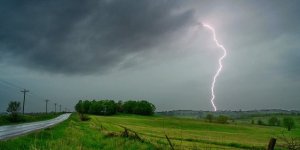| News / Science News |
Airborne science discovers complex geomorphic controls on Bornean forests
Tropical forests contain some of the most biodiverse and dynamic ecosystems in the world.

Leaf nutrient concentrations for Mt. Kinabalu: lowest (red) to mid-range (green) to highest (blue-purple). Photo: Global Airborne Observatory, ASU Center for Global Discovery and Conservation Science
The influence of precipitation, temperature, and soils is especially noticeable when comparing the towering trees found in low elevation forests to the hardier, shorter ones found at the tops of tropical mountains. These factors create an ever-changing ecosystem, with each niche harboring different species of uniquely adapted trees.
Scientists have sought to understand the links among geology (the rock types that soils originate from), biogeochemistry (feedbacks among environmental conditions, nutrient cycling, and plants), biodiversity (the variety of life in an ecosystem), and biogeography (how trees are distributed across a landscape) to paint a more complete picture of how life coevolved with our planet.
Now, in a new study, researchers at Stanford University and Arizona State University used maps of leaf chemistry, high-resolution topography data, and computer models to reveal new insights into the processes governing these complex interactions.
The study analyzed data from Mt. Kinabalu in Malaysian Borneo -- a 4,095-meter (13,435-feet) high mountain harboring a wide diversity of trees across varied terrain.
As tropical rains drench the mountain's surface, elevation differences between its shallow slopes and steep peaks create imbalances in soil erosion rates -- generally, the steeper the hill, the faster rain rushes down its surface, taking soil with it.
Soils carry nutrients needed by plants to grow, and erosion contributes to the distribution of these plant-required nutrients. Some areas become nutrient-rich and others become nutrient-poor, influencing the kinds of trees that can grow there.
Adding to this process, some soil types are more or less prone to erosion than others depending upon their geologic origins and can contain more nutrients plants need than others.
"The implications of these important results for managing land-use and vegetation distributions, and for monitoring and predicting the effects of climate change, could be far-reaching," says Justin Lawrence, a program director in NSF's Division of Earth Sciences. (National Science Foundation)
YOU MAY ALSO LIKE





